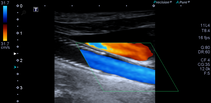
PD Dr. Wolf-Dirk Niesen
Oberarzt
Neurointensiv - Neuromonitoring, hämodynamische Modulation
Die wissenschaftliche Arbeitsgruppe „NeuroIntensiv – Neuromonitoring und hämodynamische Modulation“ von Arbeitsgruppenleiter PD Dr. Wolf-Dirk Niesen und Co-Arbeitsgruppenleiter (IHA) Dr. Johann Lambeck befasst sich mit klinischen Fragestellungen, die zur Verbesserung der Diagnostik, Überwachung und Versorgung von Patienten mit intensivpflichtigen Erkrankungen des ZNS mit einem besonderen Fokus auf neurovaskuläre Erkrankungen beitragen. Die Arbeitsgruppe verbindet moderne nicht-invasive Neuromonitoring-Methoden mit hämodynamischer Modulation zur Entwicklung individualisierter Therapiekonzepte bei intensivpflichtigen neurovaskulären Erkrankungen.
Besondere Schwerpunkte und Ziele unserer Forschung bestehen in den Bereichen:
Nicht-invasives Neuromonitoring: Moderne, bettseitig einsetzbare Methoden des nicht-invasiven Neuromonitorings sollen Komplikationen frühzeitig erkennen und gezielt radiologische Diagnostik sowie individualisierte Therapieansätze bei neurovaskulären Erkrankungen ermöglichen.
Hämodynamische Modulation: Durch individualisierte Neuromonitoring-Marker soll die zerebrale Perfusion über eine gezielte Modulation der systemischen Hämodynamik optimiert und das Outcome bei neurovaskulären Erkrankungen verbessert werden.
Diagnostik des irreversiblen Hirnfunktionsausfalls (IHA): Untersuchungen zu speziellen Patientengruppen und neuen Methoden in der IHA-Diagnostik sollen die Evidenzlage verbessern und die Diagnosesicherheit erhöhen. Zudem sollen versorgungsrelevante Fragestellungen geklärt werden.
Therapie bei aneurysmatischer Subarachnoidalblutung: In Kooperation mit der Neurochirurgie sollen neue Therapiekonzepte zur Reduktion von Blut, Abbauprodukten und Entzündungsmediatoren im Liquor sowie akute intrathekale Behandlungen das neurologische Outcome verbessern.
Diese Ziele werden in den folgenden Forschungsprojekten verfolgt:
Nicht-invasives Neuromonitoring
- SAVE-Study - Sonographig Assessment of VEntricular hemorrhage

Die Studie untersucht mithilfe transkranieller B-Bild-Sonographie die Verlaufskontrolle intraventrikulärer Blutungen. Ziel ist der Nachweis, dass Veränderungen der Echogenität eine verlässliche Bestimmung der Blut-Liquor-Clearance im 3. Ventrikel ermöglichen – sowohl durch manuelle als auch KI-gestützte Auswertung.
- DETECT-CHS - Diagnostic accuracy to DETECT Cerebral Hyperfusion after successful thrombectomy in Stroke with sonographic extracranial cerebral blood flow volumetry

Ziel der Studie ist es, die diagnostische Genauigkeit der sonographischen extrakraniellen Blutflussvolumetrie (SEBFV) zur Erkennung von Hyperperfusion (HP) nach erfolgreicher Thrombektomie zu prüfen. Zusätzlich werden Risikofaktoren und Auswirkungen der HP auf das neurologische Outcome untersucht.
- SONAS-Study - Use of the portable ultrasound system SONAS for non-invasive cerebral perfusion assessment in patients with acute stroke following mechanical thrombectomy

Die Studie nutzt ein neuartiges portables Ultraschallsystem zur Untersuchung der zerebralen Perfusion. Ziel ist der Nachweis persistierender Perfusionsdefizite oder einer Hyperperfusion nach Thrombektomie – als Basis für individualisierte hämodynamische Zielwerte.
Weitere Neuromonitoring-Studien in Kooperation mit FRONI, der IMIT und über das IGNITE-Netzwerk
Hämodynamische Modulation
- OPTIMAL-Study - Optimizing cardiac out-Put To Increase cerebral penumbral perfusion in large Middle cerebral Artery ischemic Lesion
Randomisierte, kontrollierte, outcome-geblindete Studie zum Einfluss systemischer hämodynamischer Parameter auf das Outcome von Schlaganfallpatienten mit persistierenden Gefäßverschlüssen. Verglichen werden die Standardtherapie (MAP-Anhebung) und eine erweiterte Therapie unter zusätzlicher Optimierung der Herzauswurfleistung.
- OPTIMAL-CPI-Study – Reevaluation of Optimizing cardiac out-Put To Increase cerebral penumbral perfusion in large Middle cerebral Artery ischemic Lesion using Cardiac Power Index
Untersuchung des Cardiac Power Index als Maß der kardialen Pumpleistung in Bezug auf penumbrale Perfusion (Surrogatparameter) und klinisches Outcome.
IMPOSE-Study - Individualized hemodynamic Management Post thrombectomy in large vessel Occlusion StrokE.
Multizentrische, randomisierte Studie im IGNITE-Netzwerk zum Einfluss einer individualisierten Blutdrucksteuerung (basierend auf postinterventionellem Gefäßbefund) im Vergleich zur Standardtherapie nach mechanischer Thrombektomie.
Diagnostik des Irreversiblen Hirnfunktionsausfalls
- PRO-ECCD-Study - PROspective investigation of Extracranial duplex sonography for the detection of Cerebral Circulatory arrest in brain Death
Multizentrische Beobachtungsstudie im IGNITE-Netzwerk zur Validierung der ausschließlichen extrakraniellen Duplexsonographie (ECCD) als Methode zum Irreversibilitätsnachweis bei IHA.
- IHA-vaECMO-Study - Applicability of sonographic methods to detect cerebral circulatory arrest in brain death in patients on vaECMO
Monozentrische Studie zur Anwendung trans- und extrakranieller Duplexsonographie bei vaECMO-Patienten, für die sie laut aktueller Richtlinien bisher nicht zugelassen ist.
- IHA-EEG-Study - Comparison of surface and needle electroencephalography in brain death
Prospektive, monozentrische Beobachtungsstudie zum Vergleich der Aussagekraft und Artefaktanfälligkeit des EEGs bei Oberflächenableitung versus Nadel-EEG-Ableitung.
- Weitere Studien zum IHA in Kooperation im IGNITE-Netzwerk, mit der DIVI-Sektion „Koma und Bewusstseinsstörungen“ und der DGN-Kommission „NeuroIntensivmedizin und IHA-Diagnostik“
innovative Therapieansätze bei aSAB
- SPLASH-Study - Stereotactic Cisternal Lavage in Patients with Aneurysmal Subarachnoid Hemorrhage with Urokinase and Nimodipine for the Prevention of Secondary Brain Injury
Teilnahme an einer randomisierten, outcome-geblindeten Studie der Neurochirurgie zur zisternalen Lavage bei aneurysmatischer SAB zur Reduktion sekundärer Hirnschäden.
Lambeck J, Bardutzky J, Strecker C, Niesen WD. Prospective Evaluation of a Modified Apnea Test in Brain Death Candidates that Does Not Require Disconnection from the Ventilator. Neurocrit Care. 2024 Dec;41(3):1038-1046. doi: 10.1007/s12028-024-02035-w. Epub 2024 Jul 1. PMID: 38951444.
Bardutzky J, Kollmar R, Al-Rawi F, Lambeck J, Fazel M, Taschner C, Niesen WD. COmbination of Targeted temperature management and Thrombectomy after acute Ischemic Stroke (COTTIS): a pilot study. Stroke Vasc Neurol. 2024 Jun 21;9(3):258-267. doi: 10.1136/svn-2023-002420. PMID: 37612052.
Lambeck J, Strecker C, Niesen WD*, Bardutzky J*. Prospective investigation of extracranial duplex sonography for the detection of cerebral circulatory arrest in patients with irreversible loss of brain function. Nervenarzt. 2023 Dec;94(12):1139-1147. German. doi: 10.1007/s00115-023-01521-4. Epub 2023 Jul 21. PMID: 37477664.(*shared senior authorship)
Niesen WD, Schlaeger A, Bardutzky J, Fuhrer H. Correct Outcome Prognostication via Sonographic Volumetry in Supratentorial Intracerebral Hemorrhage. Front Neurol. 2019 May 8;10:492. doi: 10.3389/fneur.2019.00492. PMID: 31133979.
Niesen WD, Rosenkranz M, Weiller C. Bedsided Transcranial Sonographic Monitoring for Expansion and Progression of Subdural Hematoma Compared to Computed Tomography. Front Neurol. 2018 May 28;9:374. doi: 10.3389/fneur.2018.00374. PMID: 29892260.
Die vollständige Literaturliste finden Sie bei PubMed.
Mitglieder
PD Dr. Wolf-Dirk Niesen, Gruppenleiter
Dr. Johann Lambeck, Co-Arbeitsgruppenleiter (IHA)
Oleksandr Avtieniev, Facharzt
Dr. Lara Beurer-Kellner, Ärztin
Egzone Gashi, Ärztin
Linda Kuth, Ärztin
Dr. Stephan Petrik, Arzt
Dolores Petrovic, Ärztin
Maria Schulte, Ärztin
Dr. Sandra Strümpell, Fachärztin
Dr. Mirjam Zinner, Fachärztin
Universitätsklinikum Freiburg
Deutschland
- IGNITE-Netzwerk der DGNI
- DIVI-Sektion „Koma und Bewusstseinsstörungen“ und -Sektion „Studien und Standards“
- DGN-Kommission „NeuroIntensivmedizin“
- DGNI-Nachwuchspreis für die OPTIMAL-Studie
Neurointensive – Neuromonitoring and Hemodynamic Modulation
The research group “NeuroIntensive - Neuromonitoring and Hemodynamic Modulation” led by the group leader PD Dr. Wolf-Dirk Niesen and co-group leader (ILBF) Dr. Johann Lambeck deals with clinical issues that contribute to improving the diagnosis, monitoring and care of patients with CNS diseases requiring intensive care, with a particular focus on neurovascular diseases. The research group combines modern non-invasive neuromonitoring methods with hemodynamic modulation to develop individualized therapy concepts for neurovascular diseases requiring intensive care.
Our research has a particular focus and aims in the following areas:
Non-invasive neuromonitoring: modern, bedside methods of non-invasive neuromonitoring are intended to detect complications at an early stage and enable targeted radiological diagnostics and individualized therapy approaches for neurovascular diseases.
Haemodynamic modulation: Individualized neuromonitoring markers are intended to optimize cerebral perfusion through targeted modulation of systemic haemodynamics and improve the outcome of neurovascular diseases.
Diagnosis of irreversible loss of brain function (ILBF): Studies on special patient groups and new methods in ILBF diagnostics are intended to improve the evidence base and increase diagnostic certainty. In addition, care-relevant questions are to be clarified.
Treatment of aneurysmal subarachnoid haemorrhage: In cooperation with neurosurgery, new treatment concepts for the reduction of blood, degradation products and inflammatory mediators in the cerebrospinal fluid as well as acute intrathecal treatments should improve the neurological outcome.
These objectives are being pursued in the following research projects:
Non-invasive neuromonitoring
- SAVE-Study - Sonographig Assessment of VEntricular hemorrhage

The study uses transcranial B-scan ultrasonography to investigate the follow-up of intraventricular hemorrhage. The aim is to prove that changes in echogenicity allow a reliable determination of blood-cerebrospinal fluid clearance in the 3rd ventricle - both by manual and AI-supported evaluation.
- DETECT-CHS - Diagnostic accuracy to DETECT Cerebral Hyperfusion after successful thrombectomy in Stroke with sonographic extracranial cerebral blood flow volumetry

The aim of the study is to test the diagnostic accuracy of sonographic extracranial blood flow volumetry (SEBFV) for the detection of hyperperfusion (HP) after successful thrombectomy. In addition, risk factors and effects of HP on neurological outcome will be investigated.
- SONAS-Study - Use of the portable ultrasound system SONAS for non-invasive cerebral perfusion assessment in patients with acute stroke following mechanical thrombectomy

The study uses a novel portable ultrasound system to examine cerebral perfusion. The aim is to detect persistent perfusion deficits or hyperperfusion after thrombectomy - as a basis for individualized hemodynamic target values.
Further neuromonitoring studies in cooperation with FRONI, the IMIT and via the IGNITE network
Hemodynamic modulation
- OPTIMAL-Study - Optimizing cardiac out-Put To Increase cerebral penumbral perfusion in large Middle cerebral Artery ischemic Lesion
Randomized, controlled, outcome-blinded study on the influence of systemic hemodynamic parameters on the outcome of stroke patients with persistent vascular occlusions. Standard therapy (MAP elevation) and extended therapy with additional optimization of cardiac output are compared.
- OPTIMAL-CPI-Study – Reevaluation of Optimizing cardiac out-Put To Increase cerebral penumbral perfusion in large Middle cerebral Artery ischemic Lesion using Cardiac Power Index
Investigation of the Cardiac Power Index as a measure of cardiac pumping capacity in relation to penumbral perfusion (surrogate parameter) and clinical outcome.
- IMPOSE-Study - Individualized hemodynamic Management Post thrombectomy in large vessel Occlusion StrokE
Multicenter, randomized study in the IGNITE network on the influence of individualized blood pressure control (based on postinterventional vascular findings) compared to standard therapy after mechanical thrombectomy.
Diagnostics of irreversible loss of whole brain function (ILBF)
- PRO-ECCD-Study - PROspective investigation of Extracranial duplex sonography for the detection of Cerebral Circulatory arrest in brain Death
Multicenter observational study in the IGNITE network to validate exclusive extracranial duplex sonography (ECCD) as a method to detect irreversibility in ILBF.
- IHA-vaECMO-Study - Applicability of sonographic methods to detect cerebral circulatory arrest in brain death in patients on vaECMO
Monocentric study on the use of trans- and extracranial duplex sonography in vaECMO patients for whom it is not yet approved according to current guidelines.
- IHA-EEG-Study - Comparison of surface and needle electroencephalography in brain death
Prospective, monocentric observational study to compare the informative value and susceptibility to artifacts of the EEG with surface versus needle EEG recording.
Further studies on ILBF in cooperation in the IGNITE network, with the DIVI section “Coma and disorders of consciousness” and the DGN commission “Neurointensive medicine and ILBF diagnostics”
Innovative therapeutic approaches for aSAB
- SPLASH-Study - Stereotactic Cisternal Lavage in Patients with Aneurysmal Subarachnoid Hemorrhage with Urokinase and Nimodipine for the Prevention of Secondary Brain Injury
Participation in a randomized, outcome-blinded neurosurgery study on cisternal lavage in aneurysmal SAH to reduce secondary brain damage.
Selected publications
Lambeck J, Bardutzky J, Strecker C, Niesen WD. Prospective Evaluation of a Modified Apnea Test in Brain Death Candidates that Does Not Require Disconnection from the Ventilator. Neurocrit Care. 2024 Dec;41(3):1038-1046. doi: 10.1007/s12028-024-02035-w. Epub 2024 Jul 1. PMID: 38951444.
Bardutzky J, Kollmar R, Al-Rawi F, Lambeck J, Fazel M, Taschner C, Niesen WD. COmbination of Targeted temperature management and Thrombectomy after acute Ischemic Stroke (COTTIS): a pilot study. Stroke Vasc Neurol. 2024 Jun 21;9(3):258-267. doi: 10.1136/svn-2023-002420. PMID: 37612052.
Lambeck J, Strecker C, Niesen WD*, Bardutzky J*. Prospective investigation of extracranial duplex sonography for the detection of cerebral circulatory arrest in patients with irreversible loss of brain function. Nervenarzt. 2023 Dec;94(12):1139-1147. German. doi: 10.1007/s00115-023-01521-4. Epub 2023 Jul 21. PMID: 37477664.(*shared senior authorship)
Niesen WD, Schlaeger A, Bardutzky J, Fuhrer H. Correct Outcome Prognostication via Sonographic Volumetry in Supratentorial Intracerebral Hemorrhage. Front Neurol. 2019 May 8;10:492. doi: 10.3389/fneur.2019.00492. PMID: 31133979.
Niesen WD, Rosenkranz M, Weiller C. Bedsided Transcranial Sonographic Monitoring for Expansion and Progression of Subdural Hematoma Compared to Computed Tomography. Front Neurol. 2018 May 28;9:374. doi: 10.3389/fneur.2018.00374. PMID: 29892260.
The complete publication list can be found on PubMed.
Members
PD Dr. Wolf-Dirk Niesen, Principal Investigator
Dr. Johann Lambeck, Co-Principal Investigator
Oleksandr Avtieniev, Medical Specialist
Dr. L. Beurer-Kellner, Physician
Egzone Gashi, Physician
Linda Kuth, Physician
Dr. Stephan Petrik, Physician
Dolores Petrovic, Physician
Maria Schulte, Physician
Dr. Sandra Strümpell, Medical Specialist
Dr. Mirjam Zinner, Medical Specialist
Collaborations
University Hospital Freiburg
Germany
- IGNITE-Network of the DGNI
- DIVI-Section „coma“ und -Section „studies and standards“
- DGN-Board „Neuro Intensive Care“
Funding
- DGNI-Young talent award for the OPTIMAL study

